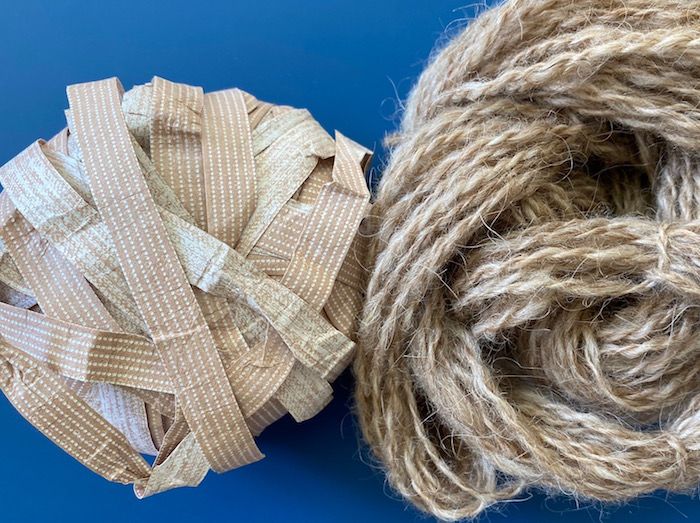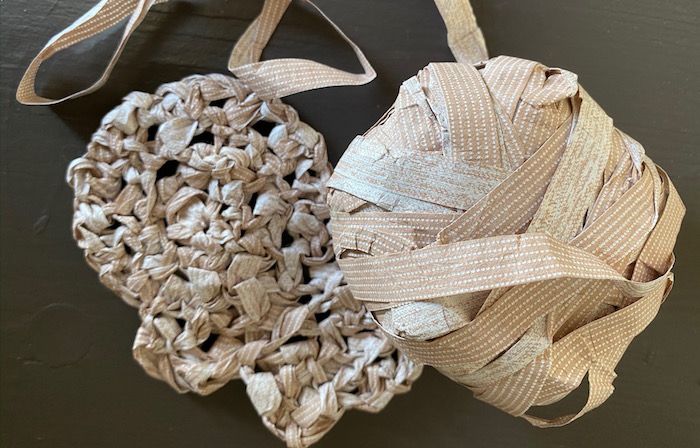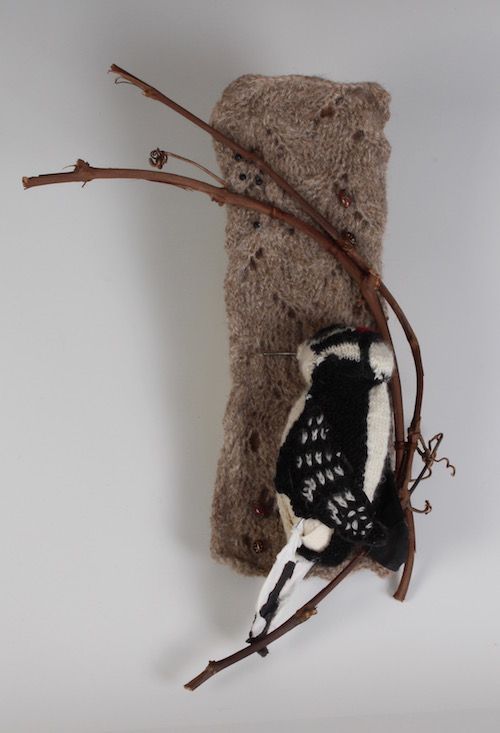
Insect Control (detail), handspun yarn, felted wool yarn, mulberry paper, grapevine, canvas, beads, wire, 16 x 11 x 3 inches, $450. © 2018 Eve Jacobs-Carnahan
Oh, to touch the artwork
Lately, I’ve been thinking about the tactile aspect of artwork. The materiality of yarn is a big reason why I work with it. It’s a bummer that we are stuck seeing new artwork on computer screens rather than in person these days. We are missing part of the experience.
There’s no single way to characterize the sensation of fiber or textiles. Take yarn, for instance. It can be warm, soft, and squishy, like the handspun alpaca/wool blend yarn on the right in the photo below. Or it can be cool, smooth, and slippery, like the Japanese paper ribbon on the left.

A childhood memory
An anthropologist or psychologist could probably tell us why we respond to surfaces they way we do. There’s probably some connection to survival buried deep in our memories. I have a childhood memory that may explain my love of yarn. It’s the memory of a favorite blanket that I slept with well into elementary school. It was a baby blanket for a crib, wool with a wide satin edge. After years of being bunched up in the grip of little hands, the satin edge became frayed and the wool wore thin. To me it was a richly textured cloth punctuated with lacy holes. That’s how I interpreted the tiny crevices and gnarly bumps that I traced with my fingers as I fell asleep.
A childhood memory
There are echoes of that blanket in the yarn and knitting I use in my artwork. I touch yarn at all stages of its transformation from fleece to yarn to fabric to sculpture. As I work with the material, the way it looks and feels changes.

alpaca wool blend roving from Kind Horn Farm, S. Duxbury, VT, and 2-ply yarn handspun from same roving
The roving on the left is a blend of alpaca and Icelandic wool that’s been commercially combed into a roving. I took that light, downy, soft fiber and handspun it on my spinning wheel. There I turned it into a soft sinuous yarn that glides through my fingers as I knit it into fabric.
Even the paper tape changes as I work with it. The smooth surface turns bubbly and bumpy when I crochet it. The action of pulling it through loops twists and turns the sturdy strip of paper, giving it a whole new character.

Japanese paper tape from Habu Textiles before and after crocheted
A bird scene you can touch
In my sculpture of the woodpecker in Insect Control, you can see another transformation. This piece juxtaposes the tight crisp black and white yarns of the bird against the felted greyish brown surface of the tree bark.
Insect Control, handspun yarn, felted wool yarn, mulberry paper, grapevine, canvas, beads, wire, 16 x 11 x 3 inches, $450. © 2018 Eve Jacobs-Carnahan. Click the image to read more about this sculpture.
The yarn for the bark is a handspun wool yarn. I knit it into an intricate lace pattern and then felted the fabric. This made the stitches meld into one another, blurring the pattern and creating a slightly fuzzy haziness. When you touch the grey bark, it feels soft and furrowed, with a bit of give. In contrast, the bird feels smooth, firm, and sleek. When you look closely, the small slippery bug beads stand out from the surface of the fuzzy bark. The photo doesn’t do it justice. But until we can get out and see artwork in person again, it will have to do.

Wonderful insights on texture and why it sparks an emotional response. Love the bird ❤️
Thanks, Lindy. I share your painter’s enthusiasm for bird subjects!